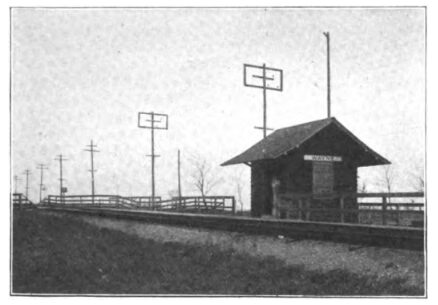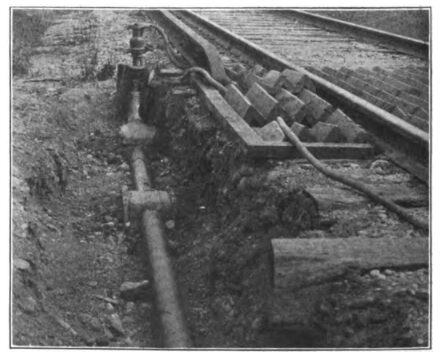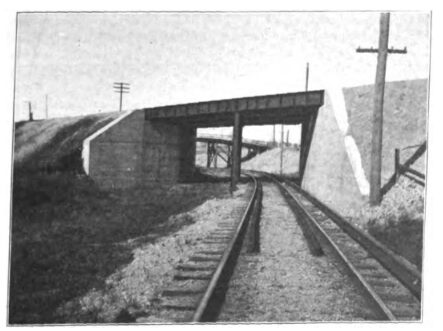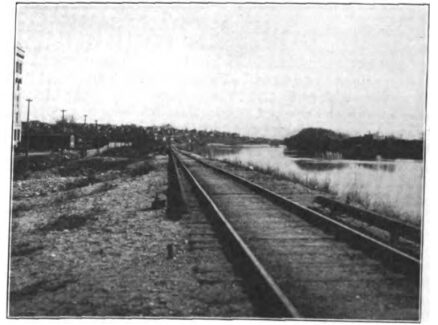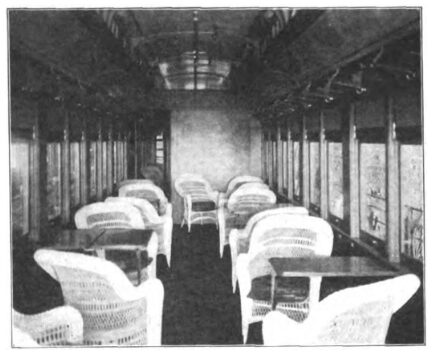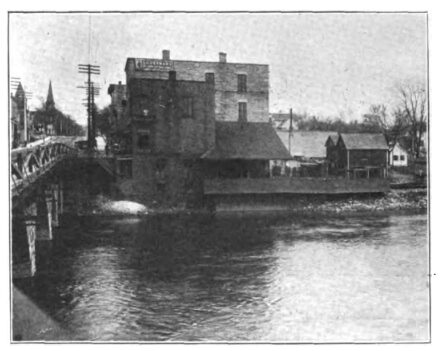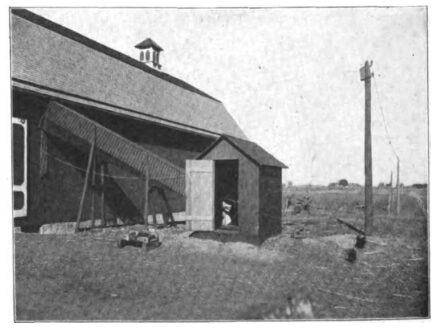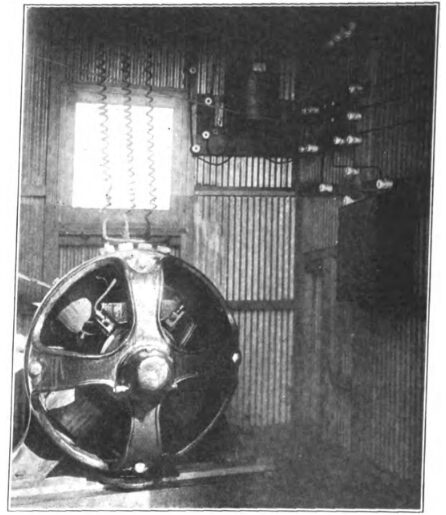[Trade Journal]
Publication: Street Railway Review
New York, NY, United States
vol. 15, no. 5, p. 286-289, col. 1-2
Some Operative Features of the Aurora, Elgin & Chicago
Railway Co.
Nearly three years of exceptionally successful operation, with a steadily increasing passenger and freight traffic, has brought about some few necessary changes in the engineering details and operation methods on the system of the Aurora, Elgin & Chicago Railway Co. At the time this road was put in operation a comprehensive description of its construction details was printed in the "Review"(Aug. 20, 1902, p . 441). It may be of interest, however, to review briefly the general description of the installation, and in connection with the description enumerate changes and additions which have been made since the former article was written.
The territory served by the Aurora, Elgin & Chicago system, extending westward from the Loop district in Chicago to the several terminal cities in the Fox River valley, 40 miles distant, was at the time this road was built very well served by five nearly parallel steam railway trunk lines, but being constructed with a view to exceptionally high average speeds, this electric road has been able to offer a schedule between its terminal cities equaling the time of the limited trains on the paralleling trunk lines and furnishing more frequent service.
| |||
| Rural Station. |
The general plan of the road conforms to the outline of the letter Y, with the Fifth Ave. terminus in Chicago as the base of the Y; the Metropolitan West Side Elevated Railway Co.'s two and four track lines to city limits and the double track route of the third-rail line to Wheaton as the vertical portion of the Y, and the two singletrack branches, one from Wheaton northwest to Elgin, 16½ miles, and one from Wheaton southwest to Aurora, 14½ miles, as the upper portion of the Y. A seven-mile branch connects the city of Batavia on the Fox River with the main line of the Aurora branch at Eola Junction.
These western termini are all served by the Elgin, Aurora & Southern Traction Co., whose north and south line parallels the Fox River from Yorkville north through Aurora, Batavia, Geneva, St. Charles, Clintonville, Elgin and Dundee to Carpentersville. This Fox River line is 40 miles long, and is controlled by the same interests as the Aurora, Elgin & Chicago, as are also the city lines in Aurora and Elgin,
The distance from Chicago to Aurora is 39.5 miles, to Elgin 41.5 miles, to Wheaton 25.4 miles, from all of which points competing steam lines offer transportation on limited express trains. There are in all about 20 towns which are served by this system, half of which may be said to be purely suburban resident towns, whose inhabitants make the journey to and from the Loop district of Chicago each day. The system also serves four large cemeteries 10 miles west of the Chicago terminus, two other cemeteries 15 miles west of Chicago, and several country clubs and recreation parks, among which are to be mentioned the Harlem Race Tracks, Glen Ellyn Lake and Park, Chicago Golf Club, Wheaton Golf Club, Riverview Park and Mill Creek Park near Aurora, Lords Park near Elgin, and Glenwood Park near the power house at Batavia. The four latter named parks are operated by the electric railway management, and have been found to be successful ventures. The natural beauties of these parks, located on the banks of the Fox River, renders them suitable locations for the annual picnics of the large fraternal societies of Chicago, and the company thus profits by the long haul of 40 miles from the city.
| |||
| Cable and Trench. |
The final location of the right of way for this system was not decided upon until exhaustive surveys and reconnaissance work had been completed. During the period of preliminary engineering and estimating all plans were made with a view for high speed operating conditions, with all proper safety. From the western limits of Chicago to the Fox River valley exceptionally few breaks occur in the alignment, and the roadbed was built with a limiting gradient of 1 per cent, this being exceeded in but one short climb out of the Fox River valley. All intersecting tangents have been joined by curves having the longest possible radii, so that there are but few portions of the line which cannot be taken at high speeds. At all railway crossings, where possible, the grades of the intersecting lines are separated . Those crossings at which the grades are not separated are protected by derails and interlocking signal apparatus, maintained jointly with the intersecting steam lines.
Track and Roadbed.
The construction of the roadbed followed the most thorough and up-to-date standards of single and double track steam railway practice. Wherever there was sufficient head room, bridges were built with ballasted floors. All piers, abutments and retaining walls are of concrete with steel reinforcement where necessary. The line is laid throughout with 80-lb. T-rails of the A. S. C. E. standard section, in 60-ft. lengths. The joints are made with 4-bolt angle bars and bonded up to the equivalent cross section with concealed, expanded terminal bonds. The entire line is gravel ballasted except on the sections near the Fox River, where crushed limestone, taken from the cuts, is used. A special 0.10 per cent carbon steel weighing 100 lb. per yard and supported at a distance of 19 1/8 in. from the gage line of the surface rail, and 11 3-16 in. above the ties, serves for the working conductor. There are several types of third-rail insulators used on different parts of the system. Each type has its advantages and dis-advantages. Those having wood as an insulating medium have occasionally caught fire and burned, while those using special insulating compounds have developed a mechanical weakness.
| |||
| Subway Near Elgin, |
At the wing fences of all highway crossings and at cross-overs and similar places it was necessary to discontinue the third rail and allow the car to cross the break under its momentum. At the farm crossings these breaks are 33 ft. long, one rail length having been left out of the third rail. Wherever these breaks occur the ends of the third rail are electrically joined by insulated underground cables varying in cross section from 1,500,000 to 50,000 c. m., depending upon the probable carrying capacity needed at the individual points. Part of these cables are insulated with rubber and part with paper, covered with sheathing of lead and protected by woven jute. Some trouble has been experienced with leakage and burning out of the cables as originally installed. This is thought to be due to electrolysis of the lead sheath and a possible admission of moisture to the special terminal which protects the end of the cable and furnishes a connection point for the bond between the ends of the cable and the third rail. Several different methods of installing these cables and different terminals have been tried with varying success.
The following described method of installing crossing cables has now been used for a year and has proven itself to be a safe one: The lead and jute covered insulated cable is drawn through a conduit of bituminized fiber and placed in the trench about three feet deep. This conduit is in 7-ft. lengths with special joints and elbows for turning the angles at the terminals of the cable. When the conduit and cable are made up and finally placed in the trench, all the joints of the conduit are grouted and anchored in a bed of concrete. In place of the old scheme for running the vertical portions at the ends of a cable in cast iron pipes strapped to ties buried in the ballast, the present arrangement has substituted for this a plank box, rectangular in section, which furnishes drainage for the cable terminal and a firm base for the lower collar of the cable-head to rest upon. A special design of cable terminal manufactured by the Ohio Brass Co. is now used.
The third rail is bonded at each joint with two 500,000 c. m. solid terminal foot bonds expanded hydraulically into holes hydraulically punched through the base of the rails. These were furnished by the Mayer & England Co, At the sub-stations the third rail is broken and fed in each direction. On the double track portion of the line no electrical connection is made between the two third rails, which are both in the "devil's strip." In event of third-rail short circuits, this allows the troublesome portion to be more easily cutout.
At all important highway crossings, and other points where cars stop, platforms of plank with a protecting railing have been built, and at nearly all of these platforms small wayside shelter houses have been erected. An accompanying illustration is a typical view of such a stopping point. Warning signs are placed at all crossings, and those stations at which limited trains do not stop are indicated by a neat sign about two feet square. The crossing signs are of a permanent design, being made of steel throughout and securely set in the ground. Pedestrians are cautioned against trespassing on the tracks by suitable boards bearing a warning sign in white letters on a black background. All highway crossings which are not protected by gates have automatic warning signals using a large gong and a series of five lights enclosed in a suitable box. These are automatically thrown on and off the third-rail circuit by a relay which is connected to a pony third rail at the proper distance from the crossing, set on the opposite side of the track from the conductor rail and energized with current from the shoes of a passing car.
Terminals.
There are terminal buildings at the ends of all branches of the system. The Chicago entrance for the line is over the Metropolitan West Side Elevated structure from the incline at 52d Ave. to the new joint terminal station at Fifth Ave. near Jackson Boulevard. This terminal was described and illustrated in the "Review" for March, 1905, page 182.
In the center of the cities of Aurora and Elgin, at the terminus of each of these two routes, terminal stations are operated jointly with the Elgin, Aurora & Southern Traction Co. At Aurora a store front is used and in it are located a restaurant, a notion store, waiting room and ticket office. All the city cars pass this building. It serves as a terminus of the Aurora, Elgin & Chicago line, the Fox River lines and the Joliet, Plainfield & Aurora Railroad Co.
The terminal building in Elgin extends through the block from the main street, where the city cars and those of the Fox River lines pass, to the right of way of the Aurora, Elgin & Chicago line, which is between the rear of the building and the Fox River.
In order to gain an entrance to the center of the city of Elgin and remain on a private right of way, it was necessary for the company to purchase a mile of river front, from the terminal station south, and build a roadbed high enough to avoid trouble from floods. An accompanying illustration shows the roadbed at nearly the southern end of this piece of construction work. There were in all about 200,000 cu. yd. of embankment required at this point. This filling material was obtained from the deep cuts which it was necessary to make in order to obtain a gradual rise out of the Fox River valley. Within a few miles south of Elgin the line intersects the Chicago Great Western Ry. and the Chicago, Milwaukee &St. Paul Ry. At each of these crossings the electric track passes under the steam track and substantial subways have been built, one of which is illustrated.
| |||
| Roadbed Near Elgin. |
The terminal of the Batavia branch is on the main street of the city and at the east end of the highway bridge over the Fox River. This building, which is illustrated, is of native stone, three stories in height. The lower floor is on a level with the tracks which extend under the shelter of the building. On this floor is a restaurant. The second floor is on a level with the street and is utilized as a waiting room, ticket office and news stand. The third floor is leased to a telephone company for its Batavia central office. The Fox River line is about three blocks west from the Aurora, Elgin & Chicago terminal and across the river. This line also has a waiting room and station on the same street as the one which has just been described
Train Service.
Since Mar. 11 , 1905, when a new schedule was made effective, both limited and local service has been offered between the Fox River terminals and the Fifth Ave. terminal, in Chicago. Trains are also run for handling milk, freight, express and newspapers. The first train in the morning arrives at Chicago at 6 o'clock and trains leave Chicago at night up to 1 o'clock in the morning. The week day schedule furnishes hourly trains from Elgin and Aurora, to Wheaton and Chicago. The trains leave Elgin at the even hour and Aurora at 30 minutes past the hour. There are two limited trains from each of the Fox River terminal cities, towards Chicago at the morning and from Chicago at the evening rush hours .These are sandwiched between the regular hourly trains from each of these termini. This combination furnishes regular half hour service between Wheaton and Chicago throughout the day, except during the morning and evening rush hours, when the addition of limited trains makes the headway 15 minutes. The local cars are scheduled to make their run between Elgin or Aurora, and the Fifth Ave. Terminal, in Chicago, distances of 41.5 and 39.5 miles respectively, in 1 hr. 25 min. The limited trains make but three stops between the Fox River valley points and Chicago; these are Wheaton, Glen Ellyn and Lombard. The limited running time is 1 hr. 10 min . A shuttle car on the Batavia branch furnishes hourly service during the middle of the day and half hourly service at rush hours, connecting at Eola Junction with the trains running between Aurora and Chicago.
| |||
| Interior of Buffet Car. |
The General Electric Co. Type-M multiple unit control with which all cars are equipped, allows great flexibility in making up the trains for the different classes of service. During the morning and evening rush hours two and three car trains are needed in and out of Chicago. Part of these trains are broken up so that it is not necessary to dead-head any cars to the terminals for the limited service. This arrangement of schedule is such that during the entire day there are only 14 passing points on the single track portions of the road and these passings all occur on one of two sidings.
The Sunday schedule furnishes half hourly service between Elgin, Aurora, Batavia and Wheaton, and 15 minutes service between Wheaton and Fifth Ave., and all passings are made at the same two sidings, one of which, at Eola Junction, is a mile long. There are no limited trains on Sunday.
This week day schedule operating 24 regular trains each way and having only one passing point on each branch, which is used as a passing point but seven times during the day, and then only by limited trains, greatly reduces the element of danger from collision, and except in case of disarrangement of schedule, always assures a clear headway with but one car on each single track branch and a half hour headway on the double track branch. This allows for extra high speeds when necessary to make up time, the value of which condition is illustrated when it is stated that during the first month of operation no train was late into the Fifth Ave. terminal at Chicago. Extra cars are, however, kept at this terminals so that in event of incoming trains being delayed the regular train may still be sent out from the terminal at its schedule time. A car starter and an inspector are kept at the Chicago terminal to care for this end of the service and otherwise assist the dispatcher and repair department.
All excursion, theater, milk, paper, express and freight trains are run as specials. There are 34 standard passenger cars, 24 of which are equipped with four 125-h. p. motors and all are equipped with multiple unit control, Five of the trail cars which were last received are 53 ft. 3 in. long, 5 ft. longer than the earlier type, and are fitted with toilet rooms. The equipment for handling freight consists of a motor car and standard freight cars. This motor car weighs 40 tons and has four 125-h. p. motors geared to 40 miles per hour with Type-M control and M. C. B. couplers.
| |||
| Batavia Terminal. |
A passenger traffic soliciting department with an office in the Fifth Ave. terminal has charge of all arrangements for special business and advertising. Illustrated pamphlets and standard folders are used. Time cards, showing the arrival and departure of all trains, are issued for each town served and the interesting points on the system are being illustrated on a set of souvenir postal cards .Several combination trips are specially advertised: The "panhandle" route from Chicago to Elgin, Elgin to Aurora on the Fox River line, and back to Chicago from Aurora via the third-rail line; the "Loop-the-loop" trip from Chicago to Joliet on the Chicago & Joliet electric railway, Joliet to Aurora on the Joliet, Plainfield & Aurora line, then return to Chicago from Aurora via the third rail line; joint excursions by the third rail line and boats to the Lake Michigan points served by the excursion steamers . These special trips are advertised in the Chicago newspapers and by large posters on the bill-boards in the several terminal cities.
| |||
| Farm Installation. |
Both special and general freight are handled. The special freight consists of a milk business of about 225 cans each day, the transportation of express for the West Suburban Express Co. from Chicago to the outlying towns where it is unloaded to delivery wagons, and the carrying of the early morning newspapers from Chicago to all towns on the line. This newspaper train carries between 4 and 10 tons of papers each day. These are loaded by means of a special elevator, which raises them from the street to the level of the car floor on the elevated structure at Canal St. The company is paid for handling the newspaper and express matter at a set rate of so much per pound carried an unlimited distance.
The general freight handled consists of standard railway car loads which are transferred from the connection with the Chicago Junction Ry. and Chicago Great Western Ry., at Bellewood [sic] Bellwood, to the Fox River valley. The Aurora, Elgin & Chicago has connections with six steam railways; Chicago Great Western Ry., Chicago Junction Ry., Chicago, Burlington & Quincy Ry., Illinois Central R. R., and two with the Elgin, Joliet & Eastern Ry. Some of the steam roads are now quoting freight rates into the electric railway company's cities and over its tracks; this traffic is initiated by the steam road solicitors and the proper mileage credited to the electric road.
All the train service is handled by a dispatcher in the office at Wheaton who records the time of each train as it passes the differ-ent points on the road and is reported to him by the sub-station and terminal attendants. A standard train sheet is used with additional ruling for recording the time during which the power may be off and the limits between which work trains are allowed to operate. One of these sheets suffices for 24 hours' operation. A combination train number and run number is used to designate the trains. Each motor car retaining the same numbers throughout the day, even for the east bound and odd for the west bound. This does away with the using of numbers running above 100 which would be needed ordinarily in designating in the usual way the large number of trains which are operated daily.
Train orders are issued by telephone and are copied on a special manifold blank. Each section of this blank consists of three sheets similarly printed, with proper spaces for the train numbers, meeting point, order number and signatures. The upper two of these sheets are made with carbon backs, so that when the order is written on the top sheet a like impression is made on the other two sheets. After having been repeated and checked, one of these sheets is given to the motorman, one to the conductor and the third is de-posited in a locked box, to which no one but the superintendent of transportation has access. A train clearance order printed on yellow paper with space for the train number, date, signatures and time of leaving of the last train ahead is used.
Street and Residence Lighting.
Steps are being taken to build up a lighting business in the many small towns along the route of the railway system. The company is now supplying alternating current for lighting the houses and streets of Wheaton, which city has heretofore been lighted by a municipal plant. This current is supplied by two motor generator sets with 220-h. p. induction motors and 150-kw., 4,000-volt self-exciting alternating current generators, which have been installed in one end of the Lombard station. This end of the station is entirely given over to the lighting apparatus. Current for operating the motor generator sets is taken from the 26,400-volt railway feeder circuit and reduced to 370-volts pressure by two three-phase air-cooled transformers. A neat switchboard of blue marble fitted with the controlling apparatus and feed wire switches stands between the transformers and the motor generator sets.
The distance from the Lombard sub-station to Wheaton is about eight miles, and the current is carried on a 3-phase 4-wire line between the two towns. Three aluminum wires carried on porcelain insulators are placed on a single cross-arm just below the railway high potential feeders, and the track rail is used as the grounded neutral for this 3-phase 4-wire feeding circuit. For adjusting the voltage at the point of distribution and for regulating it for lighting service, a General Electric Type-TA regulator is used, compensated for the line drop in the eight miles. This regulator so adjusts the resistance in the field circuit of the exciters of the fields of the alternating current generators in the motor-generator sets that very slight variations in voltage occur at the distribution point of the lighting service wires.
Farm Installations.
At many points along the line current is being taken from the third-rail for use in driving motors for operating farm machinery. There are now about 20 such farm installations scattered through-out the direct current distribution system. The current consumption of the motors in these installations averages about 25,000 kw. h. per month. An accompanying illustration is a view in a farm yard near Elgin, showing the motor house near the barn and the pole line, carrying the feed wires from the third-rail, a distance of about one-half mile. In connecting these installations with the third-rail, it has been found necessary to run a second wire back to the track rail because of the difficulty in obtaining a ground of sufficient conductivity to at all times of the year handle the return current, some of the installations being 1½ miles distant from the railway track.
| |||
| Interior Farm Motor House. |
The motor house shown is about 6 ft. sq. and 8 ft. high, placed about 30 ft. from the barn. A corrugated iron belt box connects the motor house with the barn, and inside the barn mounted on brackets is a line shaft with a number of different pulleys for driving the several kinds of farm machinery, such as feed cutters, fanning mills, corn shellers, circular saws or force pumps. A belt connects the pulley on the line shaft with the pulley on the motor. Fifteen and 20-h. p. motors are used for this class of service. These are the standard G. E. 500-volt, 4-pole, direct current machines mounted on a substantial wooden base, secured to the flooring by lag bolts. An interior view of the motor house shows one of these motors and the arrangement of wiring for connecting it with the line. A standard "fool proof" starting box is used and the current consumed is measured by the usual type of service meter. The main switch has a rope attached to its handles and reaching through the wall of the motor house to the barn, so that in case of trouble the current can quickly be cut off from the motor. Each installation is supplied with an extra set of motor brushes and a neatly framed card of instructions for operating the motor. A standard railway lighting railway arrester mounted on the pole nearest the motor house protects the apparatus.
This method of operating farm machinery is not an expensive one where such work must be done as on the large diary farms in this district, the expense of course varying with the amount of work done. It is stated that the average cost to each farmer is about $3 per month, and even though the cost of installation be charged to the first year operating expenses, there will still be shown a saving of about $400 for the year, over and above that ordinarily spent for manual labor and traction engine power. In each case the expense of installing the motors and other apparatus and the cost of construction of the feed line, outside of the right of way, is paid by the customer. Current is sold at flat metered rate with a specified minimum amount. It is thus seen that very little extra office work and outlay are required to bring in a steady income from the sale of this class of power.

